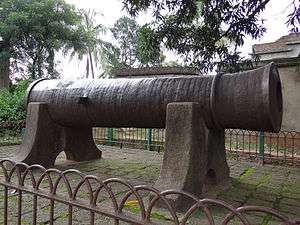Bir Hambir
| Hambir Malla Dev | |
|---|---|
| 49th king of the Mallabhum | |
| Reign | 1565 - 1620 CE. |
| Predecessor | Dhari Malla |
| Successor | Dhari Hambir Malla Dev |
| Religion | Hinduism |
Hambir Malla Dev, also known as Bir Hambir(Beera Hambeera) & Veer Hambir, was the forty-ninth king of the Mallabhum.He ruled from 1565 to 1620 CE.[1][2][3]
Personal life
Hambir was the 49th ruler of the Malla dynasty who flourished around 1586 AD and ruled in 16th-17th century, and was a contemporary of the Mughal emperor Akbar. He fought on the side of Akbar against the Afghans and paid an annual tribute to the Muslim viceroys of Bengal and thus acknowledged their suzerainty.[4]
Bir Hambir was a pious man who started following Vaishnavism. A story in two Vaishnava works (Prem-vilasa of Nityananda Das (alias Balaram Das) and Bhakti Ratnakara of Narahari Chakrabarti) recounts the manner in which Srinivasa and other devotees were robbed by Bir Hambir while travelling from Vrindavan to Gaur with a number of Vaishanava manuscripts. However, Bir Hambir was so moved by Srinivasa’s reading of Bhagavata that he converted to Vaishnavism and gave Srinivasa a rich endowment of land and money. He introduced the worship of Madan Mohan to Bishnupur.[4]
Dev Title
During his regime (1565 to 1620), Dev title was suffixed after title Malla and Mallabhum was very safe and secured.[5]
Rashmancha

The Rashmancha is a historical building located at Bishnupur. It was commissioned by Malla king Bir Hambir in 1600 CE. During the Vaishnava Ras festival, all the Radha Krishna idols of Bishnupur town used to be brought here to be worshipped by the citizens.[6]
Dal Madal Kaman (Cannon)

Maharaja Bir Hambir goes the credit of creating this famous cannon for protecting his empire. It proves the self-protective authority of Malla kingdom and also shows the use of iron and highly urbanized perfunctory skill and the existence of great artisans and armed forces of that time.[7] Dal Madal Kaman was built by Jagannath Karmakar. The Dal Madal means destruction of enemy Dal means enemy and mardan means destruction.[8]
| Left Side of Kaman | Front Side of Kaman | Right Side of Kaman | Back Side of Kaman |
See also
References
- ↑ Dasgupta 2009, p. 36.
- ↑ Malabhum, Bishnupur-Chandra, Manoranjan; 2004; Kolkata. Deys Publishing ISBN 8129500442
- ↑ Mallik, Abhaya Pada (1921). History of Bishnupur-Raj: An Ancient Kingdom of West Bengal (the University of Michigan ed.). Calcutta. p. 129. Retrieved 11 March 2016.
- 1 2 O’Malley, L.S.S., ICS, Bankura, Bengal District Gazetteers, pp. 21-46, first published 1908, 1995 reprint, Government of West Bengal
- ↑ Dasgupta 2009, p. 22.
- ↑ "Bishnupur Sub-division". bankura.gov.in.
- ↑ "Bishnupur Sub-division". bankura.gov.in.
- ↑ Dasgupta 2009, p. 55.
Sources
- website on Bankura
- Kumkum Chatterjee. "Cultural flows and cosmopolitanism in Mughal India : The Bishnupur Kingdom" in Indian Economic and Social History Review Vol. 46 (2009), p. 147-182.
- Dasgupta, Gautam Kumar; Biswas, Samira,; Mallik, Rabiranjan, (2009), Heritage Tourism: An Anthropological Journey to Bishnupur, A Mittal Publication, p. 22, ISBN 8183242944
- O’Malley, L.S.S., ICS, Bankura, Bengal District Gazetteers, pp. 21–46(25), 1995 reprint, first published 1908, Government of West Bengal